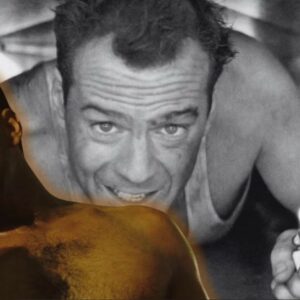Introduction
Bruce Willis, renowned for his roles in action-packed films such as “Die Hard,” has etched a lasting impression in Hollywood not just through his compelling performances, but also through his remarkable fitness journey. From his early days as a television star to becoming a leading action hero, Willis’s physical transformation is a testament to his unwavering dedication to health and fitness. This article delves into Bruce Willis’s fitness evolution, exploring how he has maintained his iconic physique over the decades.
Early Career and Physical Appearance
In the early stages of his career, Bruce Willis was more celebrated for his charismatic personality and acting prowess than his physical attributes. His breakout role as David Addison in the TV series “Moonlighting” (1985-1989) showcased his exceptional charm and comedic timing. During this period, Willis’s physique was relatively average, characterized by a casual, everyman appearance that fit the tone of his character.
At this stage, Willis’s fitness regimen was not yet a focal point of his public persona. His roles were less physically demanding, allowing him to focus primarily on developing his acting skills and establishing his career. While he was undoubtedly in good shape, his body was not yet the muscular, action-hero physique that would later become his trademark.
Transition to Action Star
The transition to an action star came with Willis’s iconic role in “Die Hard” (1988). This film marked a pivotal moment in his career and necessitated a significant transformation in his physical appearance and fitness regime. The role of John McClane, a tough New York cop who takes on a group of terrorists, required Willis to perform demanding physical feats, including high-intensity action sequences and stunts.
To prepare for this role, Willis engaged in rigorous physical training. His fitness regime was designed to enhance his strength, endurance, and agility, reflecting the demanding nature of the film. Key components of his training included:
- Weight Training: To build muscle and enhance overall strength. Willis incorporated exercises targeting all major muscle groups, focusing on compound movements like squats, deadlifts, and bench presses.
- Cardiovascular Exercises: To improve stamina and endurance. Running, cycling, and rowing became integral parts of his routine, helping him maintain high energy levels and cardiovascular health.
- Martial Arts Training: To improve combat skills and agility. Willis engaged in various martial arts disciplines, such as kickboxing and Brazilian jiu-jitsu, to execute the film’s action sequences authentically.
- Flexibility Drills: To enhance mobility and prevent injuries. Stretching and flexibility exercises were incorporated to ensure that Willis could perform complex stunts without compromising his safety.
This commitment to physical training marked a significant shift in Willis’s approach to fitness. The grueling demands of “Die Hard” set the stage for his ongoing dedication to maintaining peak physical condition.
Commitment to Fitness
As Bruce Willis continued to star in action films, his commitment to fitness became increasingly evident. The success of “Die Hard” established him as a leading action star, and maintaining his physique became essential for his career. His workout routines evolved, reflecting the need for a balanced and comprehensive approach to fitness.
Key aspects of Willis’s fitness routine during this period included:
- Strength Training: Willis focused on building and maintaining muscle mass through regular weight lifting sessions. His routine typically included exercises such as bench presses, squats, and deadlifts, performed with varying intensities and rep ranges.
- Cardiovascular Workouts: To ensure high levels of stamina and endurance, Willis incorporated various forms of cardio into his regimen. Activities such as running, swimming, and cycling helped him stay lean and energetic.
- Martial Arts and Combat Training: To enhance his combat skills and maintain agility, Willis continued to train in martial arts. This training not only improved his performance in action scenes but also contributed to his overall physical conditioning.
- Yoga and Stretching: To improve flexibility and prevent injuries, Willis integrated yoga and stretching into his routine. These practices helped him maintain a full range of motion and recover from intense workouts.
Willis’s commitment to fitness was not just about maintaining his appearance; it was also about enhancing his performance as an action star. The physical demands of his roles required a high level of fitness, and Willis’s disciplined approach allowed him to meet these demands effectively.
Challenges and Adaptations
As Bruce Willis advanced in age, he faced new challenges related to maintaining his fitness levels and adapting his routines to accommodate his evolving body. Aging naturally brings changes in metabolism, muscle mass, and joint health, and Willis had to adapt his fitness regimen to address these issues.
Some of the challenges Willis encountered included:
- Maintaining Muscle Mass: As people age, they often experience a gradual decline in muscle mass. To combat this, Willis had to focus on maintaining his strength through targeted weight training and resistance exercises.
- Joint Health and Flexibility: With age, joints can become less flexible and more prone to injury. Willis adapted his training to include low-impact exercises and stretching routines to support joint health and mobility.
- Recovery and Injury Prevention: Recovery times can increase with age, making it essential for Willis to prioritize rest and recovery. He incorporated techniques such as foam rolling, massage therapy, and adequate sleep to aid in recovery and prevent injuries.
Despite these challenges, Willis remained committed to his fitness routine. He made adjustments to his training to ensure that he could continue to stay in shape while managing the physical strain of his workouts.
Recent Years and Ongoing Fitness
In recent years, Bruce Willis has continued to embrace a fit lifestyle, even as he faced health challenges. His commitment to fitness remains evident, though his approach has shifted to focus more on sustainable health practices rather than extreme physical demands.
Key aspects of Willis’s current fitness routine include:
- Low-Impact Exercises: To reduce strain on his joints, Willis has incorporated low-impact exercises into his regimen. Activities such as swimming, cycling, and using an elliptical machine help him stay fit without putting excessive stress on his body.
- Balanced Diet: Willis has adopted a balanced diet to support overall health and energy levels. His diet includes a variety of nutrient-dense foods, such as lean proteins, whole grains, fruits, and vegetables, to maintain optimal health and performance.
- Regular Check-ups: To monitor and address any potential health issues, Willis schedules regular check-ups with healthcare professionals. These check-ups help him stay informed about his health and make any necessary adjustments to his fitness routine.
- Mind-Body Connection: Willis has placed greater emphasis on practices that support mental and emotional well-being, such as mindfulness and stress management. These practices complement his physical fitness routine and contribute to his overall quality of life.
Bruce Willis’s fitness transformation over the years is a testament to his dedication and discipline. From his early days as a television star to his status as a leading action hero, Willis has demonstrated an unwavering commitment to maintaining his iconic physique. His journey reflects not only the physical demands of his career but also the importance of adapting and evolving with age. Through a combination of strength training, cardiovascular exercises, martial arts, and a focus on overall health, Bruce Willis continues to inspire others with his remarkable fitness journey.





